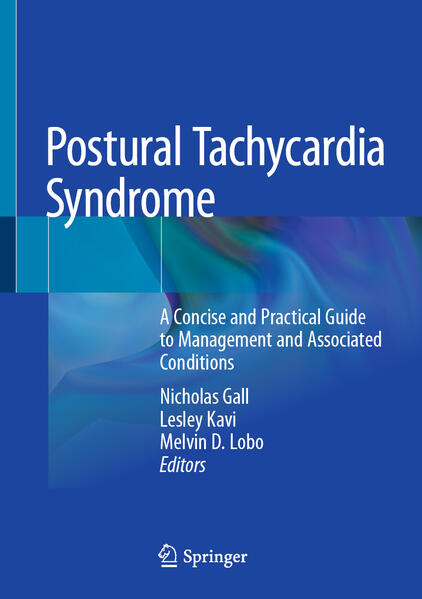
Zustellung: Fr, 04.07. - Di, 08.07.
Versand in 1-2 Wochen
VersandkostenfreiThis book describes the varying clinical manifestations of postural tachycardia syndrome (PoTS) and provides a robust yet practical set of clinical tools for those managing patients suffering with this syndrome. Guidance is provided by a range of disciplines relevant to PoTS including general and specialist assessments, associated conditions, diagnostic considerations, therapy and service models.
Postural Tachycardia Syndrome: A Concise and Practical Guide to Management and Associated Conditions presents the scientific background and practical information for the busy medical professional, illustrating key features with care-based materials to help them manage this condition, which can be a challenge for patients and clinicians alike.
Inhaltsverzeichnis
Part I - Introduction. - POTS an introduction. - What is it? . - Historical background. - Clinical presentation. - Specialties where patients may be seen. - Part II - Speciality Assessment. - Cardiological and neurological considerations. - Diagnostic criteria (not just a heart rate issue). - Pathophysiology and classification. - Tests to consider, are they useful, what do they show. - Cardiological CPET, echo, holter etc. -Neurological MRI, nerve conduction studies. - Autonomic. - The simple active stand / tilt. - Full autonomic function tests. - Red flag symptoms. - Cardiology. - Neurology MS, myopathy, epilepsy. - Overlap conditions (mitral valve prolapse, IST). - Associated neurological conditions. - Migraine. - Sleep disturbance. - Part III - Associated Conditions. - Rheumatology. - Overlap with hypermobility conditions. - New consensus guidance on hypermobility. - When toconsider serious hypermobility. - When to consider other inflammatory arthritides. - Overlap with fibromyalgia and CRPS. - Practical joint management including therapies. - Endocrinology. - What tests should we do to exclude an endocrine driver. - How can we recognise and treat the symptoms of reactive hypoglycaemia. - When do we need to consider referral to endocrinology. - Gastrointestinal manifestations. - Symptoms and causes. - What tests to do to exclude alternative conditions. - Simple and safe treatments that might help. - When to refer to the gastro clinic. - What treatment is instituted in the specialist clinic? . - Urology / Urogynaecology. - Potential symptoms. - When to consider referral? . - Investigations to consider. - Treatments. - Association with Histamine abnormalities. - Mast cell activation. - What is it? . - When does one consider it? . - What tests to do to define its presence? . - Can we treat it empirically without immunology review. - When to refer. - Audiovestibular medicine. - Recognising vertiginous contributions (migraine variant balance disorder). - When to refer and what to expect. - Part IV - Relevant Diagnostic Considerations. - Potential alternative causes. - Metabolic issues. - Lyme disease. - Chronic Fatigue syndrome. - Part V - Therapy. - Treatment. - Non-pharmacological salt, fluid, compression. - Non-pharmacological exercise. - Pharmacological when and how to use it. - Midodrine. - Ivabradine. - Betablockers. - Fludrocortisone. - Octreotide. - Pyridostigmine. - Clonidine. - Others e. g. desmopressin, EPO, SSRI, IV fluid. - Assessing benefit. - Part VI - Relevant Therapeutic Associations . - Obstetrics / Gynaecology. - Are there links with endometriosis and PCOS? . - Who should be referred and when? . - Implications for pregnancy and its management. - Pelvic floor issues. - Anaesthetic management. - Anaesthetic considerations in POTS / EDS. - Respiratory medicine . - Hyperventilation is common why and how to recognise it; why does it occur. - What clinical findings / tests can exclude other conditions. - When to refer to respiratory physio . - What management can help hyperventilation. - When to consider respiratory medicine review. - Psychological contributors. - Functional symptoms. - Stress responses. - When to involve a psychologist / psychiatrist. - CBT and other therapies. - Part VII - Service Models. - Primary Care. - When to consider referral. - Pointers in the surgery to the diagnosis. - Tests to do first. - Challenges of referral. - Shared-care arrangements. - POTS clinics. - UK models of care KCH, NHNN, Sheffield, Newcastle, William Harvey, Royal Brompton, St Mary s, Poole. - Can you set up your own autonomic tests and how do you do it? . - Nursing aspects. - Developing a nurse led clinic. - Nurse-led follow-up. - Patient aspects. - POTS-UK / STARS. - EDS UK / International HMSA.
Produktdetails
Erscheinungsdatum
21. Oktober 2020
Sprache
englisch
Auflage
1st edition 2021
Seitenanzahl
344
Herausgegeben von
Nicholas Gall, Lesley Kavi, Melvin D. Lobo
Verlag/Hersteller
Produktart
gebunden
Abbildungen
X, 332 p. 28 illus., 25 illus. in color.
Gewicht
923 g
Größe (L/B/H)
260/183/23 mm
ISBN
9783030541644
Pressestimmen
Bewertungen
0 Bewertungen
Es wurden noch keine Bewertungen abgegeben. Schreiben Sie die erste Bewertung zu "Postural Tachycardia Syndrome" und helfen Sie damit anderen bei der Kaufentscheidung.







